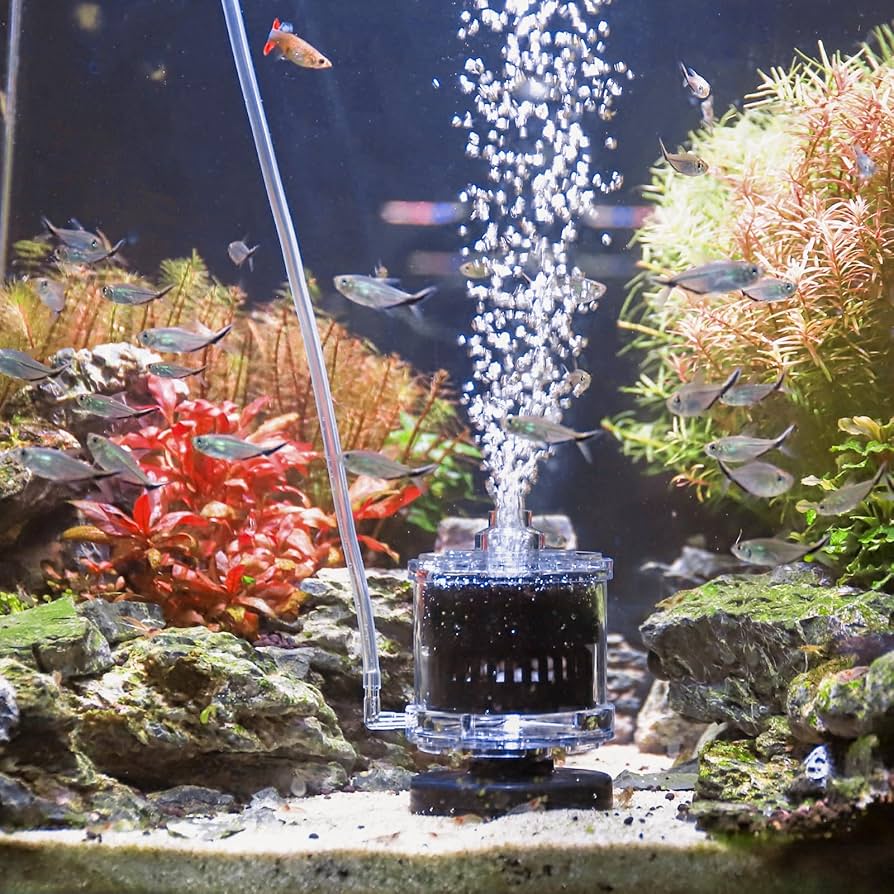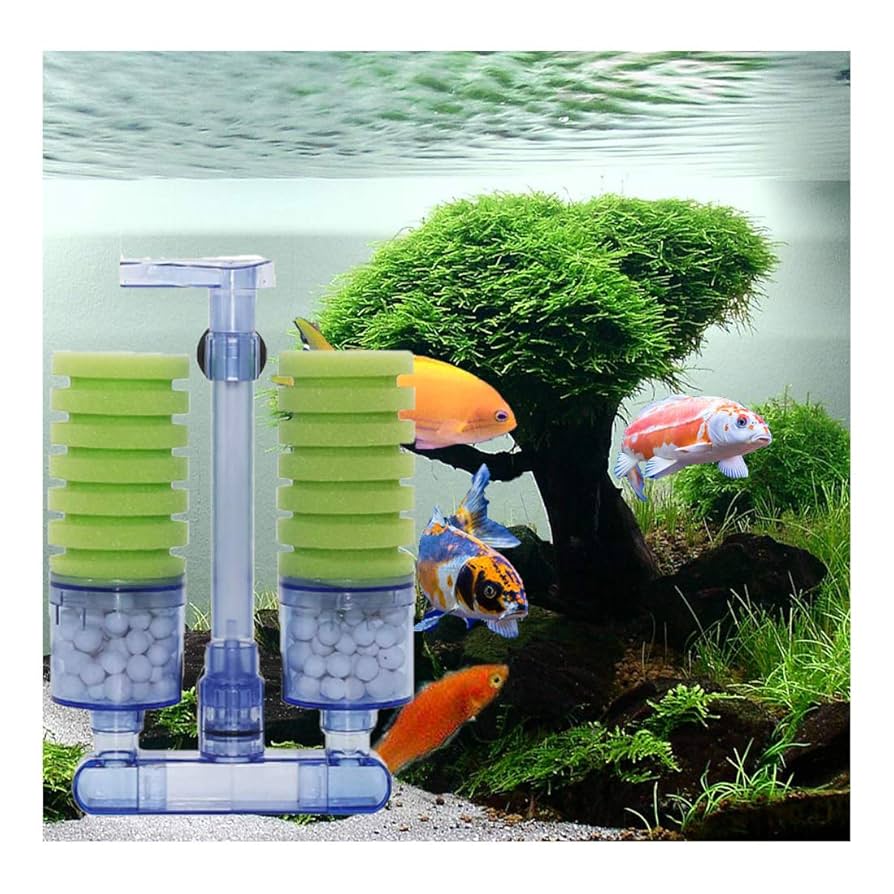Setting up a fish tank can feel overwhelming, especially when it comes to choosing the right filtration system. If you want clear water, a healthy environment for your fish, and a simple, cost-effective setup, a sponge filter might be exactly what you need.
You’ll discover how a sponge filter works, why it’s great for your fish tank, and step-by-step tips to get your tank running smoothly. Keep reading to find out how this small but powerful filter can make a big difference in your aquarium.

Credit: www.amazon.com
Choosing The Right Sponge Filter
Sponge filters are popular for fish tank setups. They offer gentle filtration and good water flow.
Picking the right sponge filter keeps your tank clean and your fish healthy.
Types Of Sponge Filters
There are several sponge filter types. Each works best for different tank needs.
- Air-driven sponge filters use air pumps to push water through the sponge.
- Power-driven sponge filters use a motor to move water.
- Corner sponge filters fit in tank corners to save space.
- Internal sponge filters sit inside the tank for easy setup.
Filter Sizes And Compatibility
Choose a sponge filter size that fits your tank. Size affects cleaning power and water flow.
| Tank Size (Gallons) | Recommended Filter Size | Notes |
| 5-10 | Small | Good for nano tanks and small fish |
| 10-30 | Medium | Suitable for community tanks |
| 30-55 | Large | Supports more fish and plants |
| 55+ | Extra Large | Best for big tanks or heavy bioload |
Check if the filter fits your tank’s size and shape. Also, see if it matches your air pump or power source.
Materials And Durability
Sponge filters are made from different materials. Choose one that lasts and is safe for fish.
- Foam sponge is common and provides good bacteria growth.
- Plastic frames hold the sponge securely.
- Check if the sponge is easy to clean without falling apart.
- Look for non-toxic materials safe for aquatic life.
Setting Up Your Fish Tank
Setting up a fish tank with a sponge filter creates a healthy home for your fish. The right setup helps maintain clean water and keeps your fish happy.
Follow simple steps to prepare your tank, substrate, and decorations. This guide covers key points for a good start.
Selecting The Tank Size
Choose a tank size that fits your space and fish needs. Larger tanks are easier to maintain and provide more stable water conditions.
- Small tanks (5-10 gallons) suit beginner fish and small spaces.
- Medium tanks (20-30 gallons) offer more room for plants and fish.
- Large tanks (50+ gallons) allow for diverse fish and decorations.
Preparing The Substrate
The substrate is the base layer in your tank. It supports plant roots and helps beneficial bacteria grow.
| Substrate Type | Best For | Notes |
| Gravel | General use | Easy to clean |
| Sand | Bottom feeders | Can compact over time |
| Aquarium soil | Live plants | Rich in nutrients |
Adding Plants And Decorations
Plants and decorations add beauty and shelter for your fish. They also improve water quality by absorbing harmful chemicals.
- Choose live plants like Java fern or Anubias for easy care.
- Use decorations without sharp edges to avoid fish injury.
- Arrange items to create hiding spots and open swimming areas.
Installing The Sponge Filter
Setting up a sponge filter in your fish tank helps keep water clean and safe. It is a simple process that benefits fish and plants.
Follow these steps to install the sponge filter properly and ensure good water quality in your tank.
Positioning The Filter
Place the sponge filter near the back or side of the tank. This keeps it hidden and avoids disturbing your fish.
Make sure the sponge is fully submerged in water. It needs to stay underwater to work correctly.
- Keep the filter away from strong currents
- Place it on a flat surface inside the tank
- Ensure easy access for cleaning
Connecting Air Pumps
Attach the airline tubing from the air pump to the sponge filter’s inlet. Use a check valve to stop water backflow.
Place the air pump above the tank or use a check valve to prevent water damage in case of power loss.
- Secure tubing to avoid leaks
- Use an adjustable air valve if possible
- Check connections regularly for tightness
Ensuring Proper Water Flow
The sponge filter should create gentle bubbles rising from the sponge. This moves water through the sponge for cleaning.
Adjust the air pump to control bubble size and water flow. Too strong flow can stress fish.
- Watch for steady bubble streams
- Reduce air if bubbles are too large
- Make sure water moves around the tank evenly
Maintaining Crystal Clear Water
Keeping your fish tank water clear is key to a healthy aquarium. A sponge filter helps trap dirt and supports good bacteria.
With regular care, you can enjoy bright, clean water that keeps fish happy and healthy.
Regular Cleaning Techniques
Clean the sponge filter every two weeks to stop clogging. Rinse it gently in tank water, not tap water, to keep bacteria alive.
Remove any debris or leftover food from the tank to reduce waste buildup. Use a siphon to clean the gravel and tank bottom.
- Rinse sponge filter in aquarium water
- Remove debris from tank surface
- Vacuum gravel regularly with a siphon
- Change 10-20% of water weekly
Monitoring Water Parameters
Test your water weekly for ammonia, nitrite, and nitrate levels. These chemicals affect fish health and water clarity.
Keep pH and temperature stable. Sudden changes can stress fish and harm beneficial bacteria in the sponge filter.
- Check ammonia, nitrite, nitrate levels
- Maintain stable pH between 6.5 and 7.5
- Keep water temperature steady for your fish species
- Use test kits for accurate readings
Avoiding Common Filtration Issues
Do not clean the sponge filter with tap water. This kills helpful bacteria and lowers filter efficiency.
Avoid overfeeding fish. Extra food clogs the filter and clouds water. Remove uneaten food after feeding.
- Never use tap water to clean sponge filter
- Feed fish only what they can eat in a few minutes
- Keep sponge filter fully submerged and running
- Replace sponge only when it falls apart
Benefits Of Using Sponge Filters
Sponge filters are popular for fish tanks. They help keep the water clean and safe.
These filters are easy to use and offer many advantages for your aquatic pets.
Biological Filtration Advantages
Sponge filters provide excellent biological filtration. They support beneficial bacteria growth.
- Improves water quality by breaking down waste
- Enhances fish health and tank environment
- Reduces ammonia and nitrite levels
Safe Environment For Fish And Shrimp
Sponge filters create a safe habitat. They are gentle on small fish and shrimp.
The sponge surface prevents tiny creatures from being sucked in. This makes it ideal for:
- Baby fish (fry)
- Delicate species
- Shrimp tanks
Energy Efficiency
Sponge filters use less power. They are a cost-effective choice for aquariums.
| Filter Type | Power Use |
| Sponge Filter | Low |
| Canister Filter | High |
| Hang-on-back Filter | Moderate |

Credit: www.amazon.com
Troubleshooting Common Problems
Setting up a fish tank with a sponge filter is simple. Still, you may face some common issues. Troubleshooting these problems helps keep your tank healthy.
This guide covers clogged filters, air pump noise, and improving filter efficiency. Each section offers clear tips to solve these issues.
Dealing With Clogged Filters
A clogged sponge filter slows water flow and harms your fish. Cleaning the sponge regularly is important to keep water clean.
- Remove the sponge from the tank carefully.
- Rinse it in a bucket of tank water. Do not use tap water.
- Gently squeeze the sponge to remove dirt and debris.
- Repeat rinsing until the water runs clearer.
- Replace the sponge and check the water flow.
Handling Air Pump Noise
Air pump noise can disturb your home and stress fish. Check the pump and use simple fixes to reduce noise.
- Place the pump on a soft surface like foam or cloth.
- Use rubber feet or pads under the pump to absorb vibration.
- Check and tighten all connections to stop rattling.
- Make sure tubing is not stretched or pinched.
- Clean the pump air filter to prevent strain.
Improving Filter Efficiency
| Tip | Reason |
| Use a larger sponge | More surface area means better filtration |
| Clean sponge regularly | Prevents clogging and maintains flow |
| Check air pump flow rate | Proper air flow moves water efficiently |
| Place sponge correctly | Ensures even water circulation |
| Replace old sponges | Worn sponges lose filtering power |

Credit: www.reddit.com
Frequently Asked Questions
What Is The Purpose Of A Sponge Filter In Fish Tanks?
A sponge filter provides gentle filtration by trapping debris and hosting beneficial bacteria. It improves water quality and oxygenates the tank, making it ideal for small or delicate fish species.
How Do You Set Up A Sponge Filter In A Fish Tank?
To set up, attach the sponge filter to an air pump. Place it inside the tank, ensuring it stays submerged. Adjust the airflow for optimal filtration without disturbing fish.
Can Sponge Filters Support Biological Filtration Effectively?
Yes, sponge filters offer excellent biological filtration. The sponge surface hosts beneficial bacteria that break down harmful ammonia and nitrites, maintaining a healthy tank environment.
Are Sponge Filters Suitable For All Types Of Fish Tanks?
Sponge filters work best in small to medium tanks and breeding setups. They are gentle, making them ideal for fry and shrimp but less effective in large, heavily stocked tanks.
Conclusion
Setting up a fish tank with a sponge filter keeps water clean and fish healthy. The sponge filter is easy to use and safe for small fish. It helps remove waste and provides good oxygen flow. Regular cleaning of the sponge is important to keep it working well.
This simple filter suits beginners and experienced hobbyists alike. Enjoy a clear tank and happy fish with this reliable setup. Try it and see how your fish thrive in a fresh environment.
